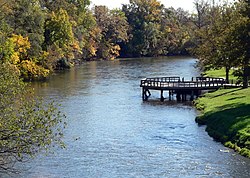
Back نهر هورون ARZ Huron River (suba sa Tinipong Bansa, Michigan, Monroe County) CEB Huron River (Eriesee, Michigan) German Rivière Huron French Huron (fiume) Italian Huron River (Michigan) SIMPLE 休倫河 Chinese
| Huron River | |
|---|---|
 Huron River in Ypsilanti | |
 A map of the Huron River and its watershed. | |
| Location | |
| Country | United States |
| State | Michigan |
| Counties | Oakland, Livingston, Washtenaw, Wayne, Monroe |
| Physical characteristics | |
| Source | Huron Swamp |
| • location | south of Andersonville |
| • elevation | 1,001 ft (305 m) |
| Mouth | Lake Erie |
• location | southeast of Rockwood |
• coordinates | 42°02′20″N 83°12′07″W / 42.039°N 83.202°W |
• elevation | 571 ft (174 m) |
| Length | 130 mi (210 km) |
| Basin size | 908 sq mi (2,350 km2) |
| Discharge | |
| • location | mouth |
| • average | 720.75 cu ft/s (20.409 m3/s) (estimate)[1] |



The Huron River is a 130-mile-long (210 km)[2] river in southeastern Michigan, rising out of the Huron Swamp in Springfield Township in northern Oakland County and flowing into Lake Erie, as it forms the boundary between present-day Wayne and Monroe counties. Thirteen parks, game areas, and recreation areas are associated with the river, which passes through the cities of Dexter, Ann Arbor, Ypsilanti, Belleville, Flat Rock and Rockwood that were developed along its banks.
The Huron River is a typical Southeast Michigan stream; mud banks, slow stream flow and a low gradient define this river. It runs through the following counties, in order from the headwaters to its mouth: Oakland, Livingston, Washtenaw, Wayne, and Monroe. There are 24 major tributaries totaling about 370 miles (600 km) in addition to the mainstream. The Huron River watershed drains 908 square miles (2,350 km2). It is the only state-designated Country-Scenic Natural River in southeast Michigan. This includes 27.5 miles (44.3 km) of the mainstream, plus an additional 10.5 miles (16.9 km) of three tributaries.
The river was named after the Huron band of Native Americans who lived in the area. In Native languages, it was called cos-scut-e-nong sebee or Giwitatigweiasibi. It was part of a Native American trade route.
The river has many dams, 19 on the main stream and at least 96 in the entire system. Most dams are only a few feet high, built to slightly increase and maintain water levels in existing lakes to provide drought protection and flood control, a use that is now environmentally controversial. However, at least a dozen dams were built for mill or hydroelectric power and several formed large new lakes behind them. Some of these on the Huron River mainstream are Kent Lake, Barton Pond, Argo Pond, Ford Lake, Belleville Lake, and Flat Rock Pond.
The Huron River flows through numerous parks and is a prime canoeing river with a generally slow current and only a few minor rapids or obstructions, except for the short Delhi rapids which is runnable by experienced canoeists and kayakers except during low water.
The river is heavily fished by sportsmen for rock bass, sunfish, bluegill, black crappie, white bass, smallmouth bass, largemouth bass, northern pike, walleye, catfish, trout, muskie, and below Belleville Dam, Coho salmon, Chinook salmon, and Steelhead. Suckers and carp are also common fish in the river.
In 2009, faculty and students from the University of Michigan produced "Mapping the River," a multimedia presentation combining dance, poetry, music, and projected images which explored the role of the Huron in communities along it.[3]
- ^ United States Environmental Protection Agency. "Watershed Report: Huron River". watersgeo.epa.gov. Archived from the original on 2021-07-03. Retrieved 2021-07-03.
- ^ U.S. Geological Survey. National Hydrography Dataset high-resolution flowline data. The National Map Archived 2012-03-29 at the Wayback Machine, accessed November 7, 2011
- ^ Mannino, Trina (12 February 2009), "University profs celebrate the Huron in 'Mapping the River'", The Michigan Daily, Ann Arbor, MI
© MMXXIII Rich X Search. We shall prevail. All rights reserved. Rich X Search